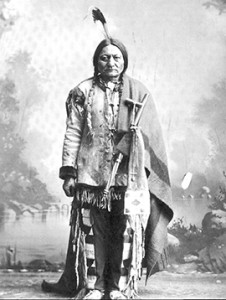He was born in what is now South Dakota. As a boy he was known as Hunkensi, which means slow. After showing great bravery in a battle against the Crow Indians, however, he received the name Sitting Bull. His father chose to call him by that name.
Historians believe Sitting Bull was born around 1834, although there is no documentation to substantiate that date. He became a famous medicine man and leader of the Hunkpapa Sioux Indians.
Many people mistakenly think that Sitting Bull was the leader of the Indians at the Battle of Little Bighorn, where on June 25, 1876, General George Custer lost his life. Actually, Sitting Bull acted only as the leading medicine man in the preparations for the battle.
The year before, he had received a vision that all his enemies would be delivered into his hands. In the spring of 1876, he led a Sun Dance at which he told the Indians to change their way of fighting. Instead of showing off to prove their bravery, they should fight to kill or they would lose all their lands to the white people. This new tactic led to the annihilation of Custer and his men.
After the Battle of Little Bighorn, Sitting Bull and his followers were driven into Canada. He returned to the United States in 1881. After two years in confinement at Fort Randall in South Dakota, he lived on the Standing Rock Reservation in that state.
There, in 1890, he helped start the Ghost Dance. The government thought this was an attempt to renew the Indian wars and sent Indian policemen to arrest Sitting Bull. In the process, he and his son were killed. Several American military men, including General George S. Patton, studied and adapted Sitting Bull’s light cavalry tactics of rapid deployment and swift flanking movements.
















Follow Us